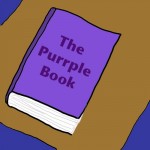When I was working within the primary sector I had the privilege to work with a steering group for able, gifted and talented pupils. This became a focus of mine and continues to be so even into higher education. What follows is an idea which I ‘magpied’ – yes a nice work for nicked – from a colleague at one of the steering group meetings. Here is how to create and the concept behind the purple book.
Often children find themselves in a class where individuals excel at a range of activities. This may be the soon to be world class footballer or the talented pianist or even the child who always answers the mathematical question the quickest (and most importantly correctly!). Self worth and confidence is something that we need to promote in all children and I decided that, while it was important for the able, gifted and talented (AGT) pupil to celebrate their abilities and not to be shy about them, it was important for all children to celebrate their abilities, no matter where or to what extend they existed. I consider myself lucky that I learnt to play the piano when I was younger, a talent which is always welcome in a primary school. I am very much aware that I am not the best pianist around accepting that I can play is very important.
So what was the Purple Book?…Well, halfway through the first term, I would sit down with the children in my class, usually in circle time, and tell them about everyone being good at something. Just like people coming together to create a building such as York Minster, it takes a lot of people with a range of different skills and what is created in the end is truly spectacular! I would say that I was keen to work together as a group and, because of this, it was important that everyone celebrated being ‘experts’ about something. Apart from being excited about this, some children would panic or even exclaim – I’m not good at anything. This is when it was important to reinforce that they didn’t have to be the best (e.g. I wasn’t the best piano player in the school but I could still play) but had to be something that they enjoyed and they knew they could be good at.
To begin with, the children then had to work by themselves to make a list about what they were good at. It was important to say that this didn’t have to be a curriculum subject – I remember clearly one boy writing, that he could make people smile! Once this was done, then the lists could be discussed but no-one was allowed to disagree at all – in fact, many children used to add other things to people’s lists – including mine! (did I mention – you have to do it as well :)). Once the lists were complete – and no-one was allowed to have more than three – you had to decide yourself which three were on your list – then they were recorded on a sheet of paper, along with a digital image of the child. This could, of course, be linked to computing and a database could have been created providing a cross-curriculum link but I always created a paper/hard copy – mainly since I wanted the children to interact an engage with it throughout the year.
Finally, my hard working teaching assistant, would paste it all together and create the Purple Book – a book of class experts. Whenever there was a question to be answered then the book would be our first point of call. Children would either provide the answer or say that they were not sure, but would find out – so extending their own understanding of their subject. I must admit, I did have a look at the book and made sure that throughout the year I would be creative with some of the questions that I asked or were asked in order to include all the children.
A similar activity that we used to complete as a class at the end of circle time was the ‘Name from the Box’. We had a box with everyone’s name within it on small pieces of card, including my name and my teaching assistant’s. At the end of every circle time, we would choose a random name from the box. That person would then be sent out of the room while the rest of the group came up with three positive things about the person. Once these had been decided upon, then the person was invited back into the room and stood by me at the front of the circle and we told them – they often stood there with a huge smile on their face. My teaching assistant would make notes and then add them to a certificate which was given to them at the end of the day to take home.
I started this waffle by talking about confidence and self-worth and, although this activity would not fully cover this subject, coupled with valuing the children’s questions and answers and promoting individuality, it certainly started to address it.
Remember keep up to date with my waffles by subscribing to;
Twitter
Blog
YouTube
Facebook
and now on iTunes!
Podcast
Have fun and catch you later!

